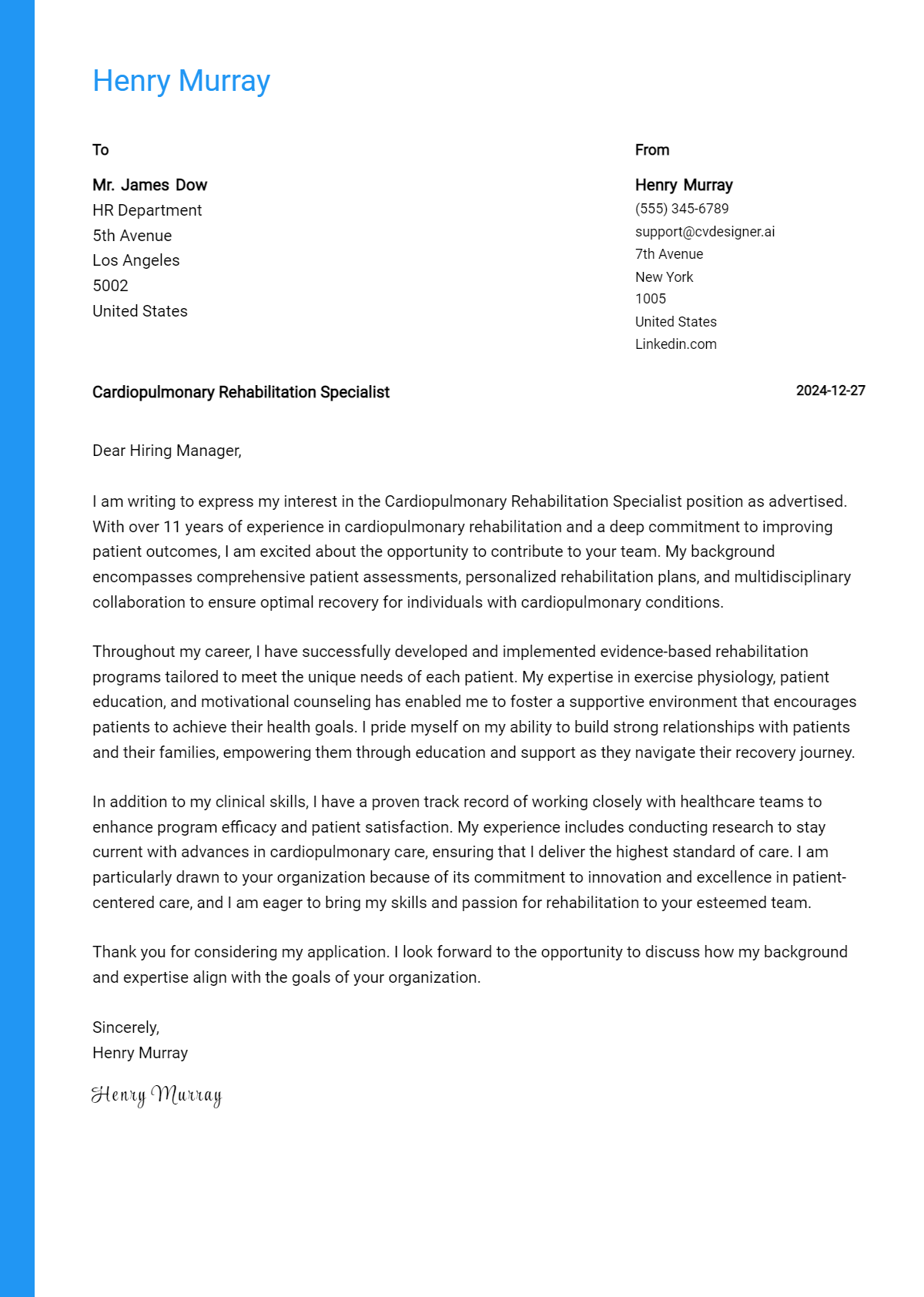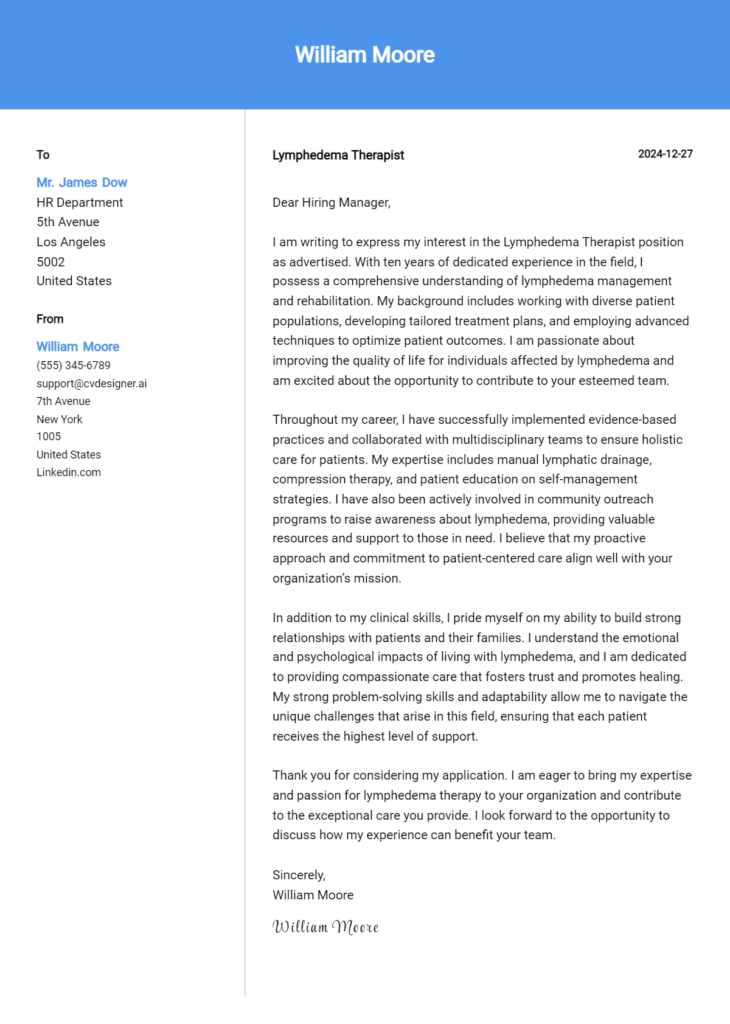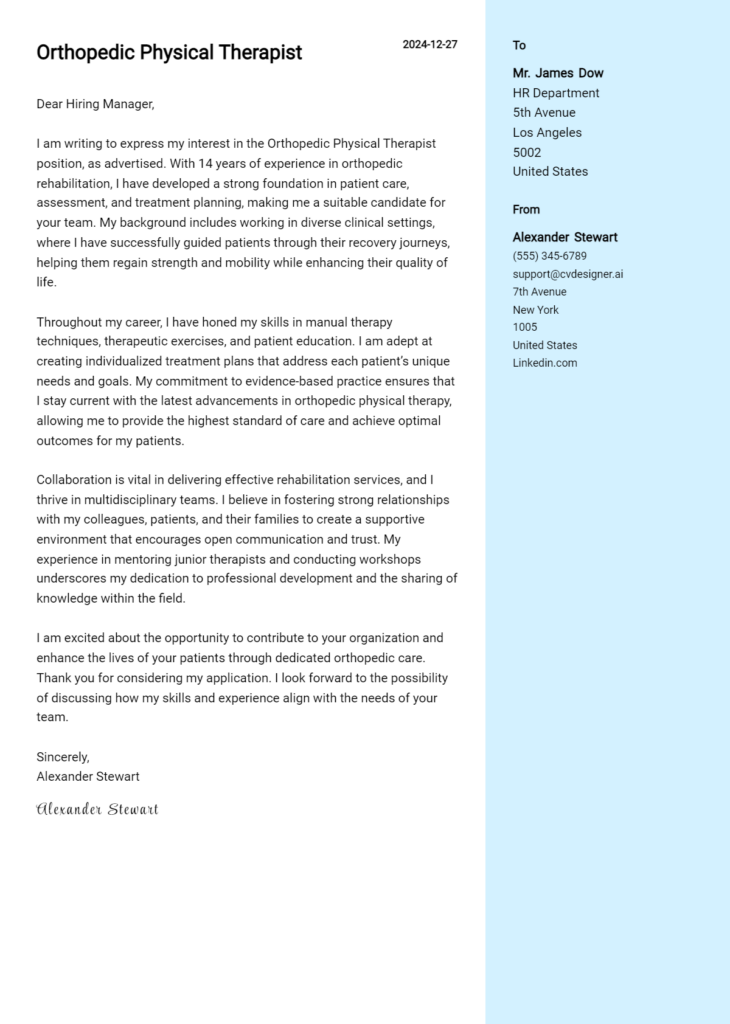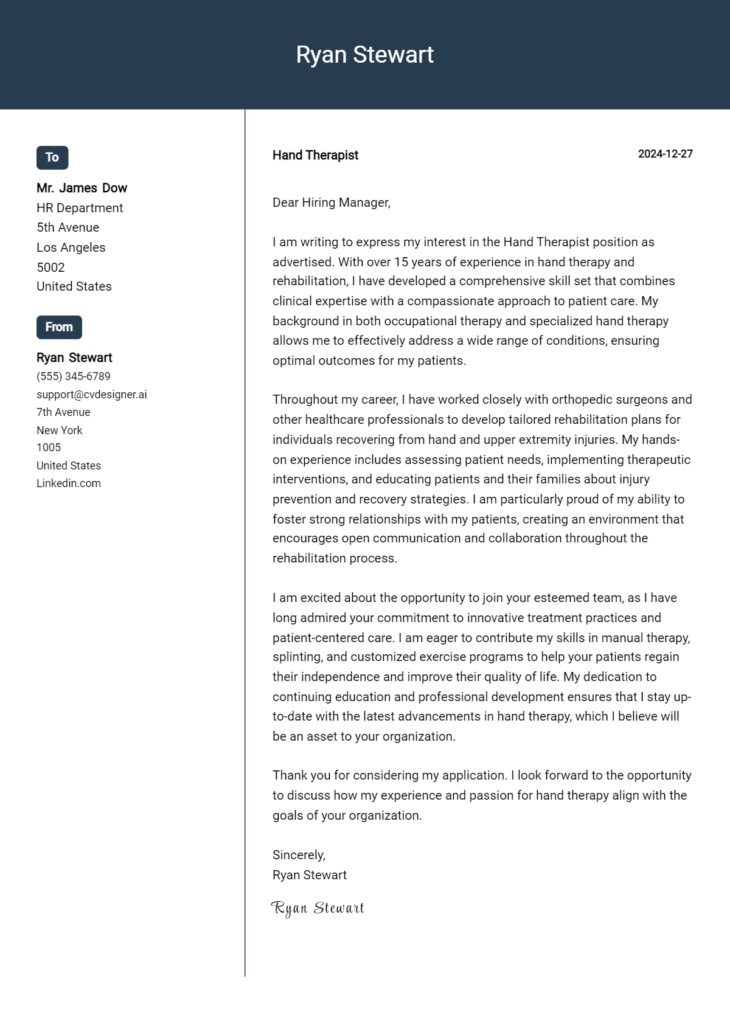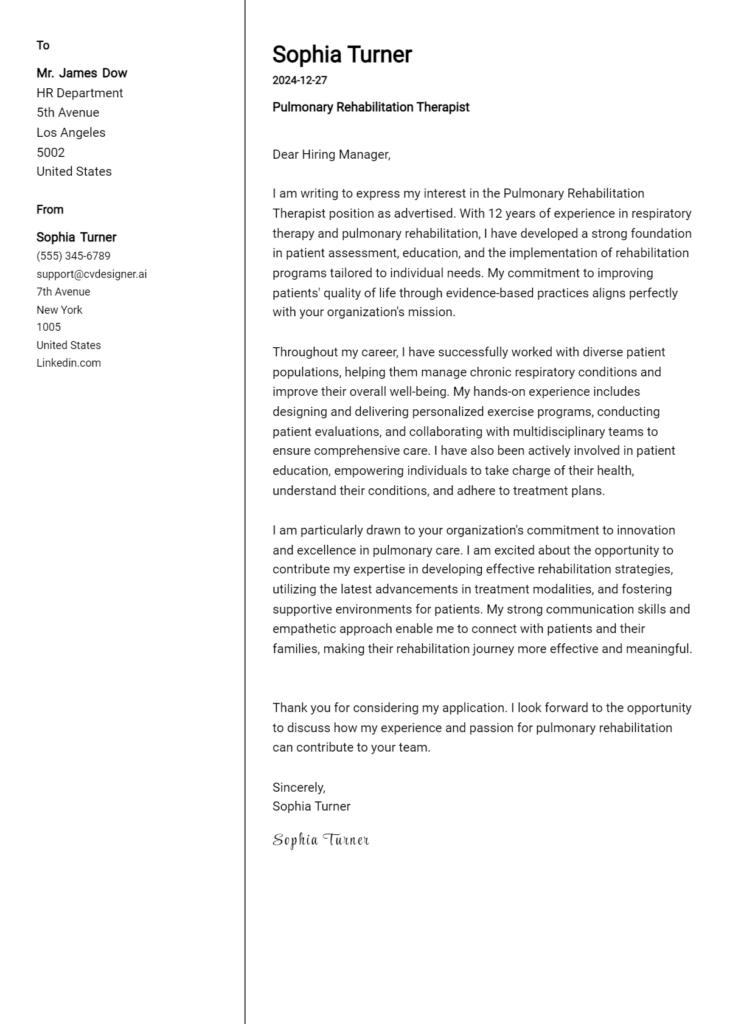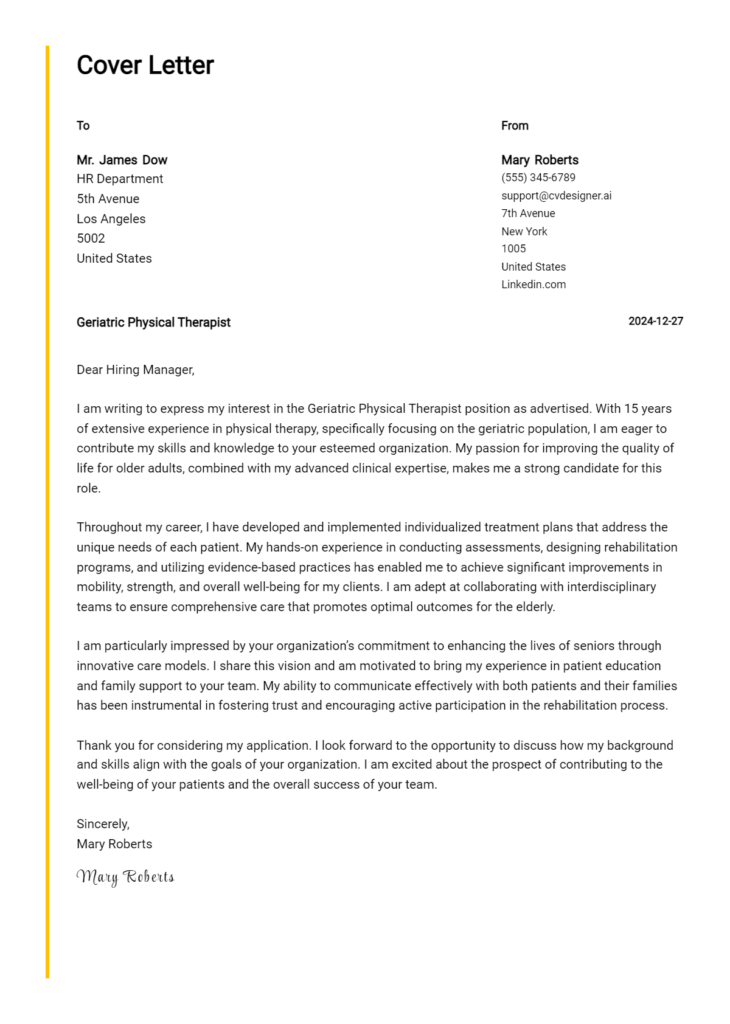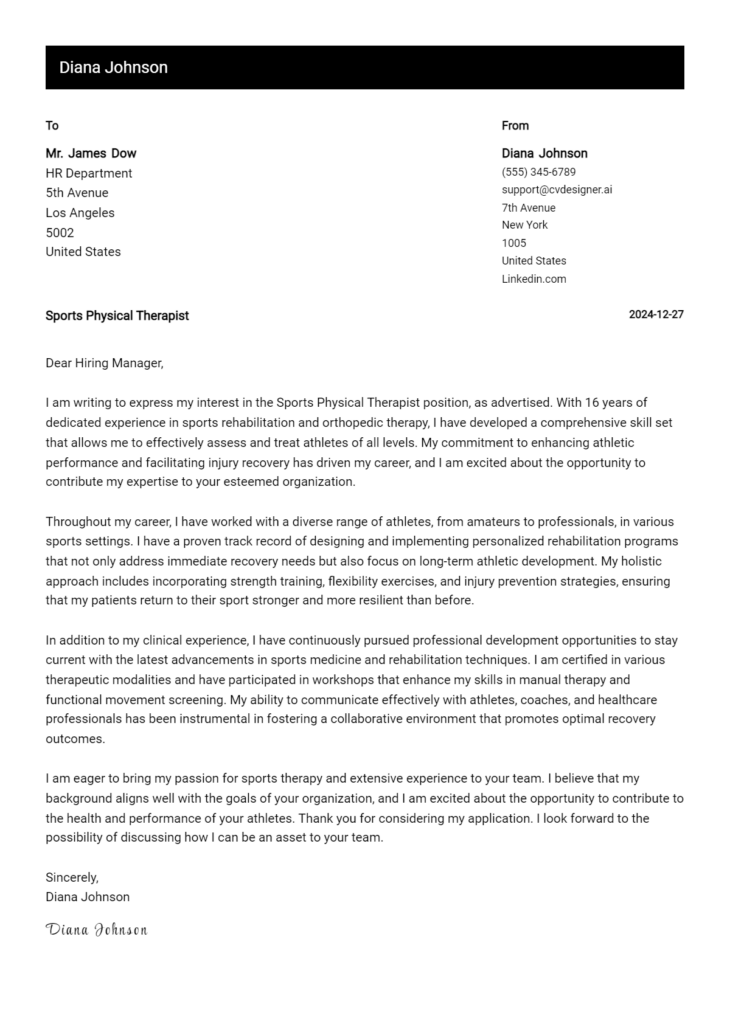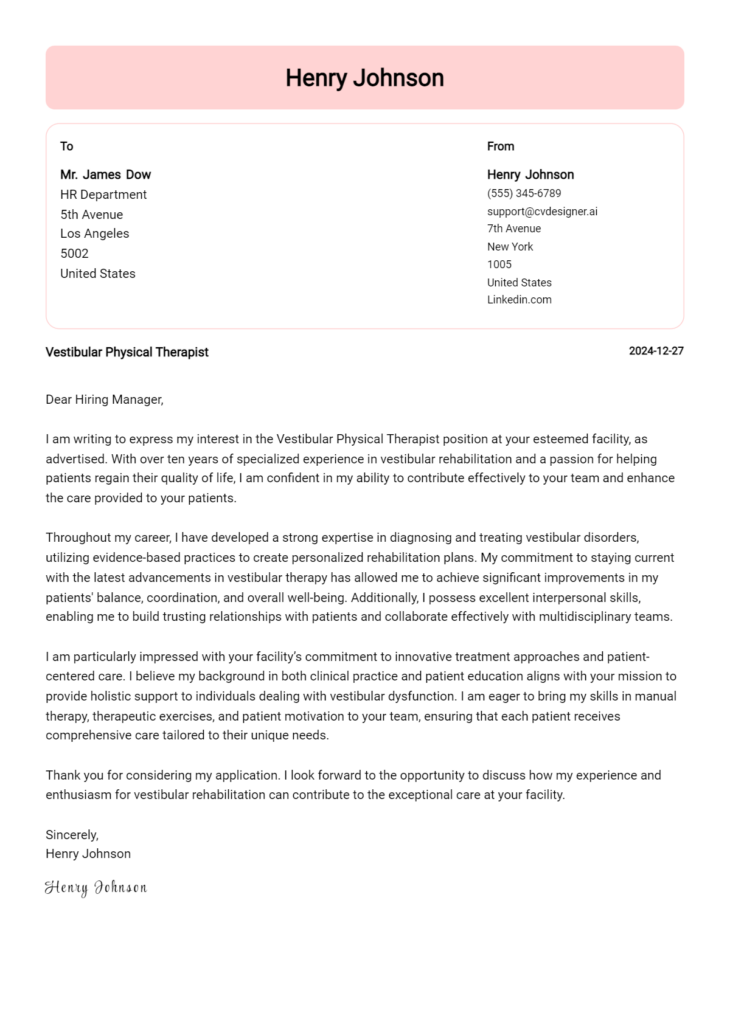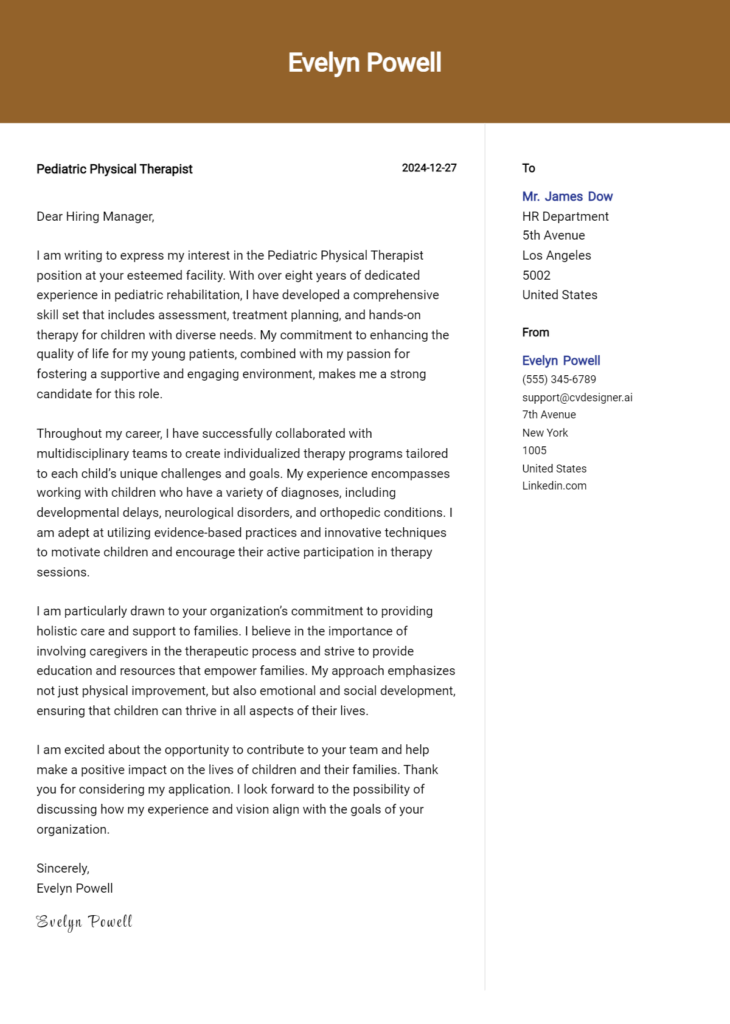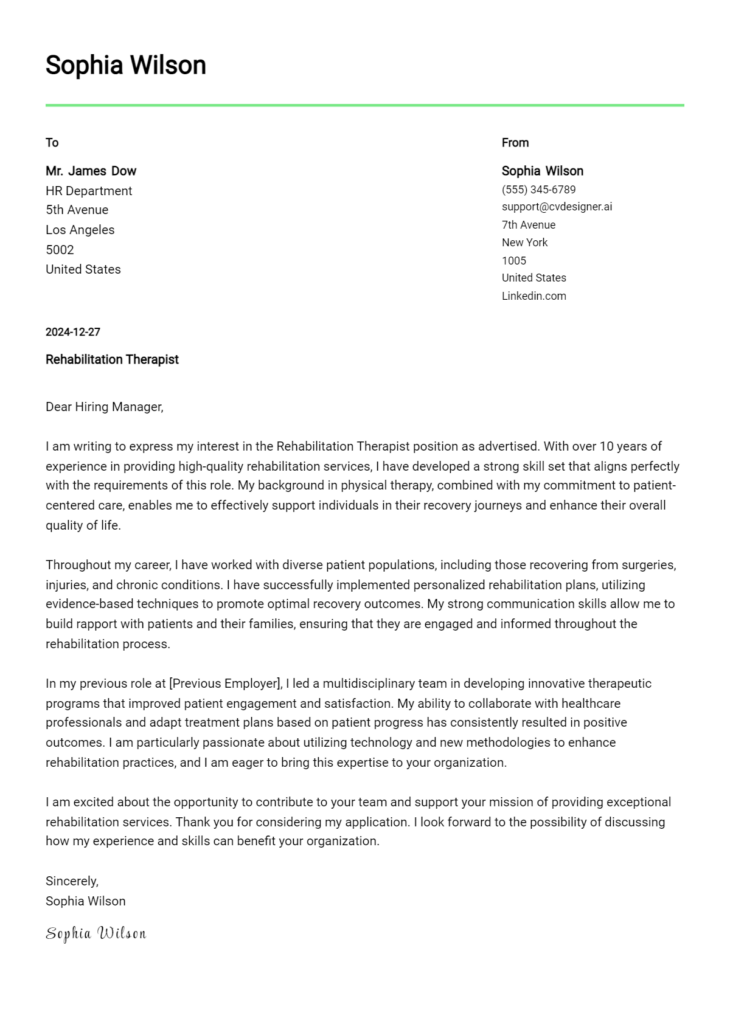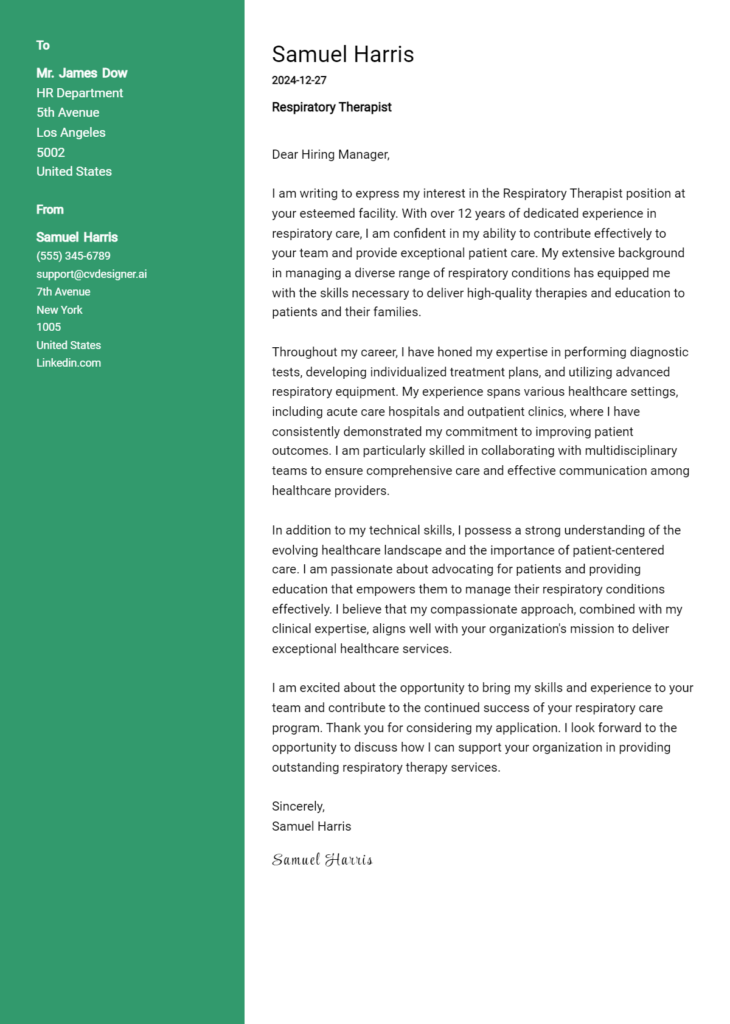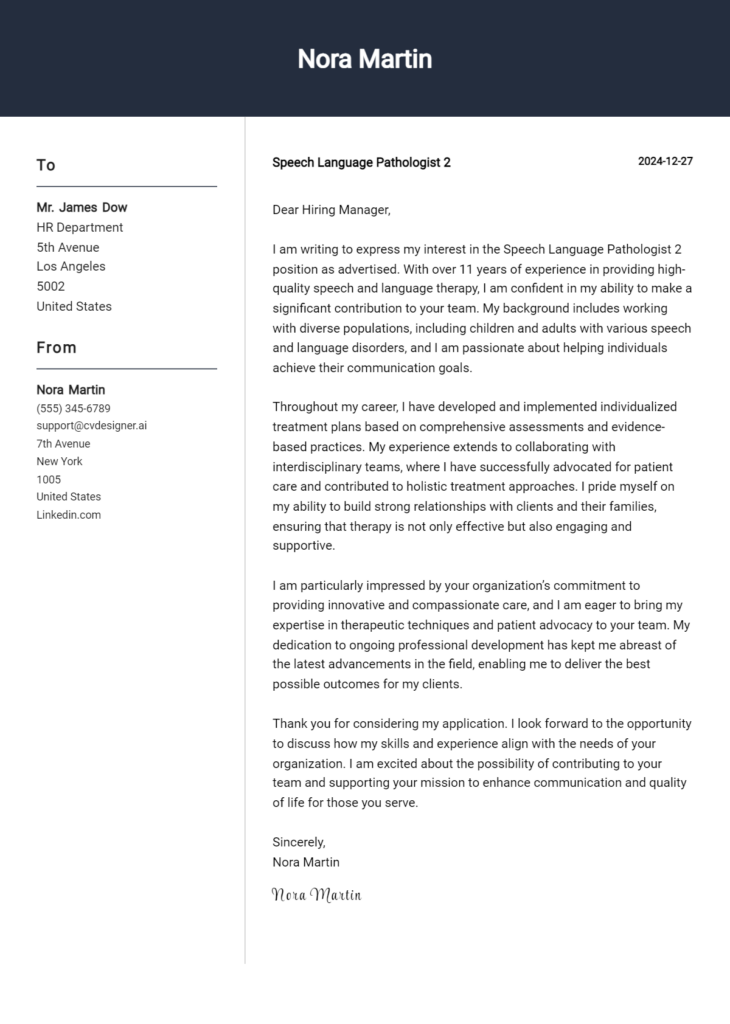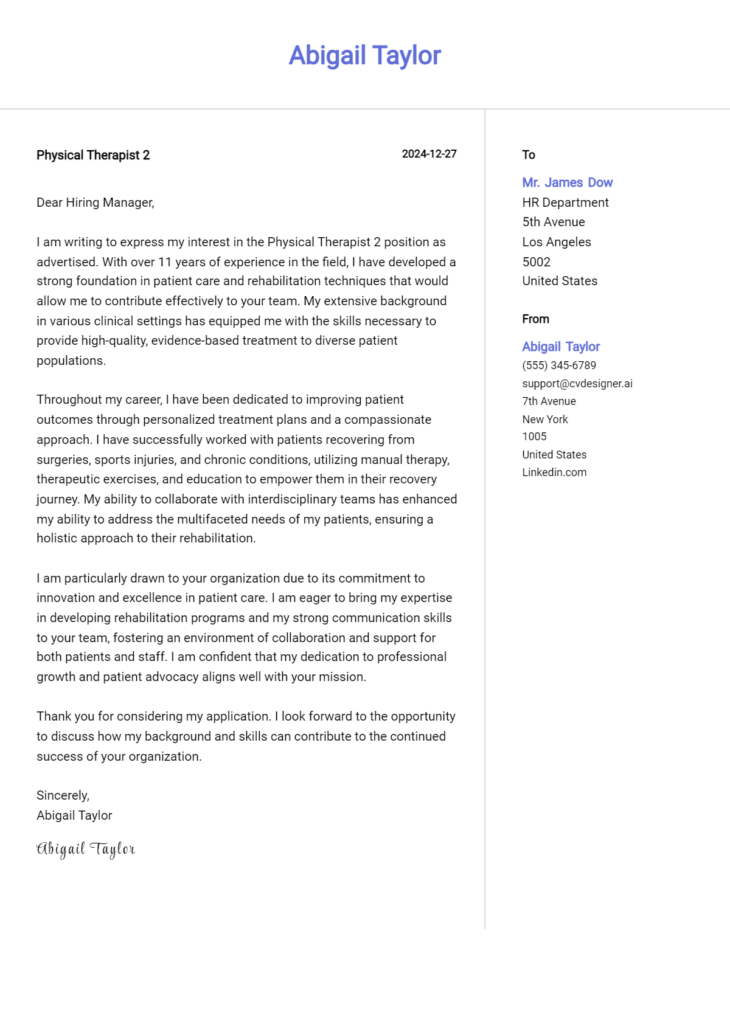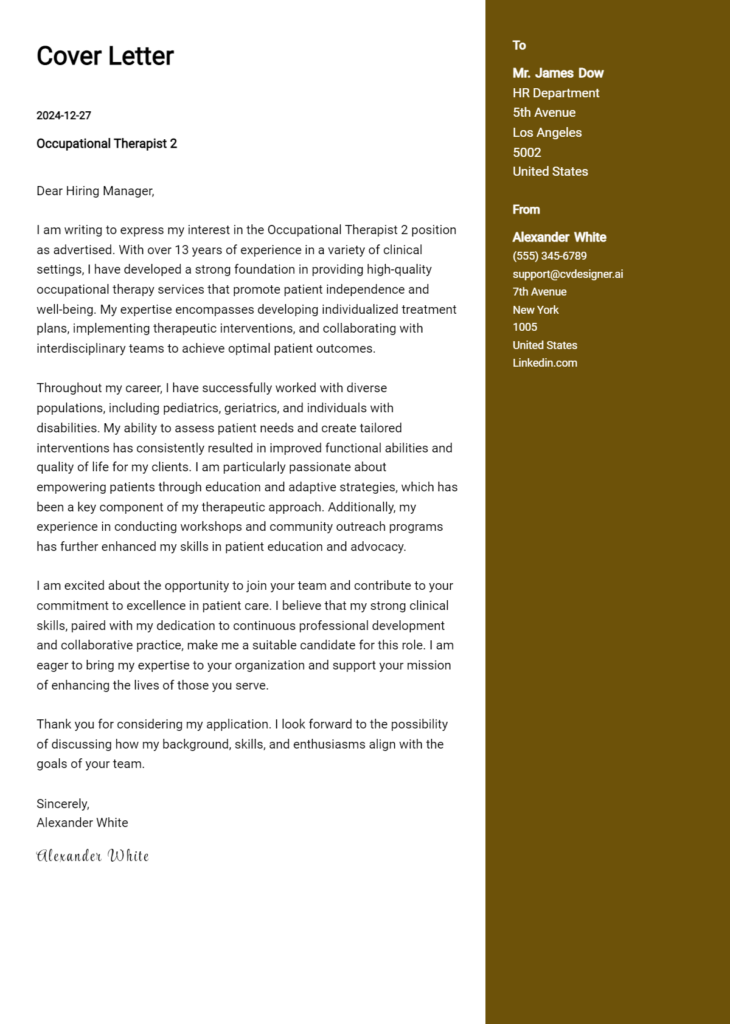Cardiopulmonary Rehabilitation Specialist Cover Letter Examples
Explore additional Cardiopulmonary Rehabilitation Specialist cover letter samples and guides and see what works for your level of experience or role.
How to Format a Cardiopulmonary Rehabilitation Specialist Cover Letter?
Crafting a compelling cover letter for a Cardiopulmonary Rehabilitation Specialist position is essential for making a strong first impression. The way you format your cover letter not only showcases your professional demeanor but also reflects your understanding of the healthcare field, where attention to detail and clarity are paramount. A well-structured cover letter can effectively highlight your qualifications, experience, and passion for helping patients achieve their health goals, ultimately capturing the interest of the hiring manager.
In this guide, we'll discuss how to format your cover letter specifically for a Cardiopulmonary Rehabilitation Specialist role, ensuring that you present your credentials in the best possible light. We will focus on the key components of a professional cover letter, including:
- Cover Letter Header
- Cover Letter Greeting
- Cover Letter Introduction
- Cover Letter Body
- Cover Letter Closing
Each section is crucial in conveying your qualifications and professionalism. Let’s delve into each part and explore how to make your cover letter stand out in the competitive healthcare landscape.
Importance of the Cover Letter Header for a Cardiopulmonary Rehabilitation Specialist
The header of a cover letter is crucial for establishing a professional tone and providing essential information at a glance. For a Cardiopulmonary Rehabilitation Specialist, a well-structured header not only demonstrates attention to detail but also ensures that the recipient can easily identify the sender and understand the context of the letter. A clear and professional header should include the applicant's contact information, the date, and the recipient's details, which helps set the stage for the rest of the correspondence.
Here are examples of a strong and weak cover letter header for a Cardiopulmonary Rehabilitation Specialist:
Strong Example
Jane Doe, RRT 123 Healing Way Wellness City, ST 12345 jane.doe@email.com (123) 456-7890 October 1, 2023 Mr. John Smith Director of Cardiopulmonary Rehabilitation Health & Wellness Hospital 456 Care Lane Wellness City, ST 12345
Weak Example
Jane D. 123 St. 10/1/23 To Whom It May Concern
A strong header conveys professionalism and respect for the recipient, while a weak header can create confusion and diminish the applicant's credibility.
The Importance of a Strong Cover Letter Greeting
The greeting of your cover letter serves as the first impression for the hiring manager and sets the tone for the rest of your application. A well-crafted greeting demonstrates professionalism and a personalized touch by addressing the recipient directly, which can help establish a connection right from the start. Avoiding generic greetings, such as "To Whom It May Concern," showcases your initiative to research and engage with the potential employer. If necessary, take the time to find the hiring manager's name through the company's website or LinkedIn. A personalized greeting not only reflects your attention to detail but also your genuine interest in the position of Cardiopulmonary Rehabilitation Specialist.
Strong Greeting Example
Dear Dr. Smith,
Weak Greeting Example
To Whom It May Concern,
Importance of a Well-Crafted Cover Letter Introduction for a Cardiopulmonary Rehabilitation Specialist
A well-crafted cover letter introduction is crucial for a Cardiopulmonary Rehabilitation Specialist, as it serves as the first impression for the hiring manager. This opening paragraph should not only capture their attention but also convey the candidate's genuine interest in the role. Additionally, it should briefly highlight key skills or achievements that make the candidate a strong fit for the position. A compelling introduction sets the tone for the rest of the cover letter and can significantly influence the hiring manager's decision to read further. Below are both strong and weak examples of cover letter introductions for this role.
Strong Example
Dear [Hiring Manager's Name], As a dedicated Cardiopulmonary Rehabilitation Specialist with over five years of experience in developing personalized rehabilitation programs for patients with cardiovascular and pulmonary conditions, I am excited about the opportunity to contribute to [Company Name]. My passion for patient-centered care, combined with my proven track record of improving patient outcomes through innovative approaches, aligns perfectly with the mission of your esteemed facility. I am eager to bring my expertise in exercise physiology and patient education to your team and help enhance the quality of life for your patients.
Weak Example
To Whom It May Concern, I am applying for the Cardiopulmonary Rehabilitation Specialist position. I have some experience in this field and think it might be a good fit for me. I hope you consider my application.
Purpose of the Cover Letter Body for a Cardiopulmonary Rehabilitation Specialist
The cover letter body serves as a crucial platform for candidates to effectively communicate their qualifications and unique offerings to potential employers in the field of cardiopulmonary rehabilitation. This section allows candidates to highlight relevant skills, experiences, and specific projects or accomplishments that showcase their ability to contribute positively to the team and the organization. By articulating measurable outcomes from past roles, such as improved patient recovery rates or successful implementation of rehabilitation programs, candidates can convey their value and alignment with the company’s goals.
Strong Example
As a dedicated Cardiopulmonary Rehabilitation Specialist with over five years of experience, I have successfully developed and implemented a comprehensive rehabilitation program that improved patient recovery rates by 30% over the last year. My role involved not only the assessment of patient needs but also the design of personalized exercise regimens that incorporated the latest evidence-based practices. Additionally, I led a project that integrated telehealth solutions into our program, which resulted in a 40% increase in patient participation during the pandemic. My commitment to providing high-quality care and my collaborative approach with multidisciplinary teams have consistently driven positive patient outcomes and satisfaction.
Weak Example
I have worked as a Cardiopulmonary Rehabilitation Specialist for a few years and have done some tasks related to patient care. I believe I can help your company because I have experience. I sometimes worked on projects, but I don't remember the details. I am good at my job and like to work with patients. I think I would be a decent fit for your team.
Importance of the Cover Letter Closing for a Cardiopulmonary Rehabilitation Specialist
The closing paragraph of a cover letter is crucial as it serves to summarize your qualifications, reiterate your enthusiasm for the position, and encourage the hiring manager to take the next steps, such as reviewing your resume or scheduling an interview. A strong closing leaves a lasting impression and reinforces your suitability for the role. In contrast, a weak closing may diminish the impact of your application and fail to motivate the employer to engage further.
Strong Example
Thank you for considering my application for the Cardiopulmonary Rehabilitation Specialist position. With my extensive background in cardiopulmonary care and my passion for helping patients regain their health, I am excited about the opportunity to contribute to your team at [Company Name]. I am eager to discuss how my skills and experiences align with your needs. I look forward to the possibility of an interview and am happy to provide any additional information needed.
Weak Example
I hope you like my resume. I think I could be good at this job. Let me know if you want to talk. Thanks.
Crafting a compelling cover letter is essential for candidates seeking the role of a Cardiopulmonary Rehabilitation Specialist. A well-written cover letter not only serves to introduce you to potential employers but also provides a platform to showcase your technical skills, problem-solving abilities, knowledge of the software development life cycle (SDLC), teamwork capabilities, and a commitment to continuous learning. Below are five tips to help you create an impactful cover letter that highlights these essential qualities.
Cover Letter Writing Tips for Cardiopulmonary Rehabilitation Specialist
Highlight Your Technical Skills
Begin your cover letter by detailing specific technical skills relevant to the role. Mention your proficiency in evaluating and interpreting cardiopulmonary data, as well as your experience with rehabilitation equipment and software. Use specific examples from your previous roles to demonstrate your expertise. This will not only catch the employer's attention but also establish your credibility.Showcase Problem-Solving Abilities
Cardiopulmonary Rehabilitation Specialists often face complex challenges in patient care. Use your cover letter to narrate a situation where you identified a problem and implemented a successful solution. This could be an instance where you improved a patient’s rehabilitation plan or adapted a treatment protocol based on individual needs. Highlighting your analytical skills and ability to think critically will set you apart from other candidates.Demonstrate Knowledge of SDLC
While the SDLC is commonly associated with software development, understanding its principles can be beneficial in a healthcare setting, especially when discussing the implementation of new technologies or systems for patient management. Briefly mention any experience you have in contributing to system improvements or technology integration within your previous roles, emphasizing how this knowledge can improve patient outcomes.Emphasize Teamwork and Collaboration
Cardiopulmonary rehabilitation is often a team effort involving various healthcare professionals. Illustrate your ability to work collaboratively by discussing your experiences in interdisciplinary teams. Provide examples of how you have effectively communicated with colleagues, shared insights, or contributed to team goals, thereby enhancing the overall patient care process.Express a Passion for Continuous Learning
The field of cardiopulmonary rehabilitation is ever-evolving, necessitating a commitment to lifelong learning. In your cover letter, share your enthusiasm for professional development. Mention any relevant certifications, workshops, or courses you’ve pursued to stay updated on the latest practices and technologies. This not only shows your dedication to personal growth but also reassures potential employers of your commitment to delivering the best care possible.
By incorporating these tips into your cover letter, you can create a persuasive narrative that captures your qualifications and enthusiasm for the Cardiopulmonary Rehabilitation Specialist role. For additional inspiration, consider exploring various cover letter templates or using a cover letter builder to streamline the writing process.
Common Mistakes to Avoid in a Cardiopulmonary Rehabilitation Specialist Cover Letter
Crafting a compelling cover letter is essential for standing out in the competitive field of cardiopulmonary rehabilitation. Avoiding common mistakes can significantly enhance your chances of making a positive impression on potential employers. Here are some frequent pitfalls to watch out for:
Generic Salutations: Using "To Whom It May Concern" can come off as impersonal. Instead, try to find the hiring manager's name for a more tailored approach.
Rehashing Your Resume: A cover letter should complement your resume, not repeat it. Focus on specific experiences and skills that highlight your suitability for the role.
Lack of Specificity: Avoid vague statements about your qualifications. Instead, provide concrete examples of your skills and successes in cardiopulmonary rehabilitation.
Ignoring Formatting Guidelines: Poorly formatted letters can detract from your professionalism. Utilize a clear cover letter format to ensure your letter is easy to read.
Spelling and Grammar Errors: Mistakes can undermine your credibility. Always proofread your letter and consider using tools to check for errors.
Failing to Customize: Sending a one-size-fits-all letter can be detrimental. Tailor each letter to the specific job and organization, demonstrating your genuine interest.
Lack of a Strong Closing: A weak conclusion can leave a poor final impression. End with a confident statement expressing your eagerness to discuss your application further.
By steering clear of these common mistakes and taking the time to create a well-crafted cover letter, you can significantly improve your chances of landing an interview. For inspiration, check out various cover letter examples to see how others have successfully navigated these challenges.
Cover Letter FAQs for Cardiopulmonary Rehabilitation Specialist
What should I include in my cover letter for a Cardiopulmonary Rehabilitation Specialist position?
In your cover letter, begin with a strong opening that captures the reader's attention. Clearly state the position you are applying for and how your qualifications align with the job requirements. Highlight your relevant experience, such as working with patients with cardiovascular or pulmonary conditions, your understanding of rehabilitation protocols, and your ability to conduct assessments and develop personalized treatment plans. Include any certifications, such as BLS or ACLS, and emphasize your communication skills, as they are essential for working with patients and healthcare teams. Finally, express your passion for improving patient outcomes and your commitment to lifelong learning in the field.
How can I demonstrate my passion for cardiopulmonary rehabilitation in my cover letter?
To effectively convey your passion for cardiopulmonary rehabilitation, use specific examples from your professional experience. Discuss any volunteer work, internships, or projects that ignited your interest in this field. You might mention a patient success story that deeply impacted you or a particular challenge you faced that reinforced your dedication to helping others. Additionally, express your enthusiasm for staying updated on the latest research and best practices in cardiopulmonary care. This will show that you are not only skilled but also genuinely invested in the well-being of your patients and the advancement of the field.
How do I tailor my cover letter for a specific job application?
Tailoring your cover letter involves researching the organization and understanding its values, mission, and specific needs. Start by reviewing the job description to identify key skills and qualifications the employer seeks. Use this information to customize your cover letter by incorporating relevant terminology and addressing how your background aligns with their requirements. Mention the organization's specific programs or initiatives in cardiopulmonary rehabilitation that resonate with you, and explain how you can contribute positively. This personalized approach demonstrates your genuine interest in the position and showcases your ability to meet their unique challenges.
What common mistakes should I avoid in my cover letter?
Common mistakes to avoid in your cover letter include generic language, vague descriptions of your experience, and spelling or grammatical errors. Ensure that you do not simply restate your resume; instead, use the cover letter to provide context and depth to your qualifications. Avoid using overly technical jargon that may alienate readers unfamiliar with specific terms. Additionally, steer clear of negative language or discussing any shortcomings. Instead, focus on your strengths and what you can bring to the role. Finally, remember to keep your cover letter concise and to the point, ideally no longer than one page, to maintain the reader's attention.
Build your Cover Letter in minutes
Use an AI-powered cover letter builder and have your letter done in 5 minutes. Just select your template and our software will guide you through the process.

